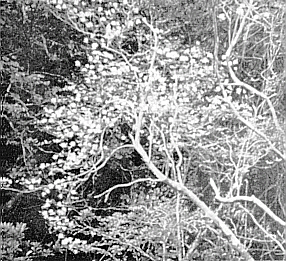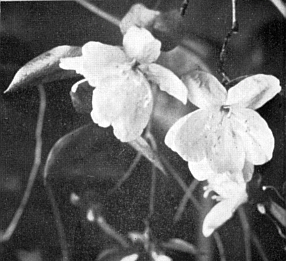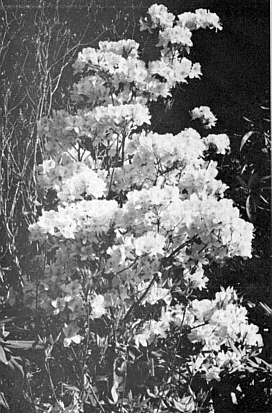QBARS - v19n1 Rhododendron tashiroi and Its Hybrids
Rhododendron Tashiroi and Its Hybrids
K. Wada, Yokohama, Japan

|

|
|---|---|
Fig. 7. The Cherry Azalea, R. tashiroi , makes a leggy tree in shade, resembling a cherry. Photo by author |
Fig. 8. Blooms of R. tashiroi showing over-winter coriaceous leaves. Photo by author |
Rhododendron tashiroi , called in Japan Cherry Azalea, is a species little known to horticulturists. It is the only species of series Azalea subseries Tashiroi, and considered by botanists a linking species between subseries Obtusum and subseries Schlippenbachii. It has deep glossy, leathery, evergreen leaves 1½ to 2" long and ¾ to 1" wide, 2 to 3 leaflets terminally. If it did not have brown, depressed, flattened hairs on the leaves, especially when bursting, it might be taken for a Rhododendron of the Triflorum series. The flowers are very pale pink, to pink, 2 to 2½ inches across, more fleshy than in most of the Azaleas. It blooms near the end of April with us.
It is wild in the extreme southern part of Japan, including Kawanabe Islands, Yakushima Island, Tanegashima Island, etc. and also in Riukiu. These southern distributions suggest tenderness but in Yakushima Island its distribution is extended from 200 ft. to 6,000 ft. above sea level, where Rhododendron yakushimanum finds itself at home and is dwarfed to stand the frigid winter, and with winter snow covers. At the 6,000 ft. elevation it is no longer subtropical, rather more like arctic. In the other areas, there are no such high hills as in Yakushima Island and so its distribution has to remain simply to the tops of the low hills. It seems not to mind summer heating and grows happily at places low enough to be considered subtropical elevations. It still remains to be tested whether the form from the 6,000 feet elevations is hardier or not. In Yakushima Island, famous for great humidity, it grows so old as to develop a trunk 3 feet in girth at breast height and as tall as 14 feet high.

|
|---|
Fig.9. Tashiroi Hybrid, Pink Pearl, no longer a cherry but a jewel. It is a hybrid of R. shikokianum x R. tashiroi hybrid. Photo by author |
A Heat-Tolerant Species
In a sunny place, R. tashiroi makes a twiggy growth well covered with the beautiful evergreen leaves but in shade it becomes leggy as is the case with all sun-loving plants. In our gardens it is a beautiful evergreen Azalea, very highly heat-tolerant and drought resistant.
Before the war I noticed it belongs more nearly to the Rhododendron weyrichii - reticulatum group morphologically than to the other Rhododendron species. I tried to cross R. tashiroi with R. shikokianum , R. nudipes and R. wadanum , expecting its progeny might show more tendency to stand drought and summer heat than the latter one, and of course with more different colors in larger sizes. The results have turned out more than I expected, because the hybrids have shown more vigor and rapid growth. All seedlings formed large, broad bushes, 7 to 8 feet high, in 15 years, with a mass of flowers. One of them has the same color as R. 'Pink Pearl' and has been named by me 'Tashiroi Hybrid Pink Pearl.' The flowers are very much enlarged, as compared with Tashiroi species and have become astoundingly showy. It is admired by everyone who sees it in bloom. It is a splendid plant as a tall specimen in our gardens and as a background plant for lower front plants.
Breeding to Enlarge the Color Range
R. shikokianum , one of the parents we used for breeding, is very near to R. weyrichii , with the same brick red flowers, and differs from R. weyrichii in minor points. It blooms at a younger age and is hardier. R. nudipes , often called R. reticulatum roseum , has large rose flowers, the color of R. albrechtii , and is itself a plant showier than R. albrechtii . R. wadanum is only different botanically from R. reticulatum and dilatatum and has purple to lavender flowers. As I crossed R. tashiroi with these species, with which it crosses freely, my present tashiroi hybrids already have many different colors. To enlarge the color range of my hybrids, I have crossed with the best of my tashiroi hybrids R. weyrichii and a pure white sport of R. dilatatum . It will take three or four years to tell the results.
Among the Azalea Obtusum subseries and Azalea Luteum subseries so many hybrids have already been raised, and they are now most important flowering shrubs in our gardens. This is the result of the endeavors of so many people in the past. If many people join me to prospect the natural secrets of Azalea Schlippenbachii subseries, we shall evidently have some thing to glorify the gardens of posterity and enlighten the lives of our descendants.
Note: According to the R. H. S. Rhododendron Handbook (1963) R. dilatatum , R. nudipes and R. wadanum have been merged with R. reticulatum and R. shikokianum has been merged with R. weyrichii . In the same Handbook R. tashiroi is not described but is marked "Q", "not at present in cultivation as far as is known." It is interesting to know therefore, that this species is in cultivation and has been used in breeding. - Ed.

